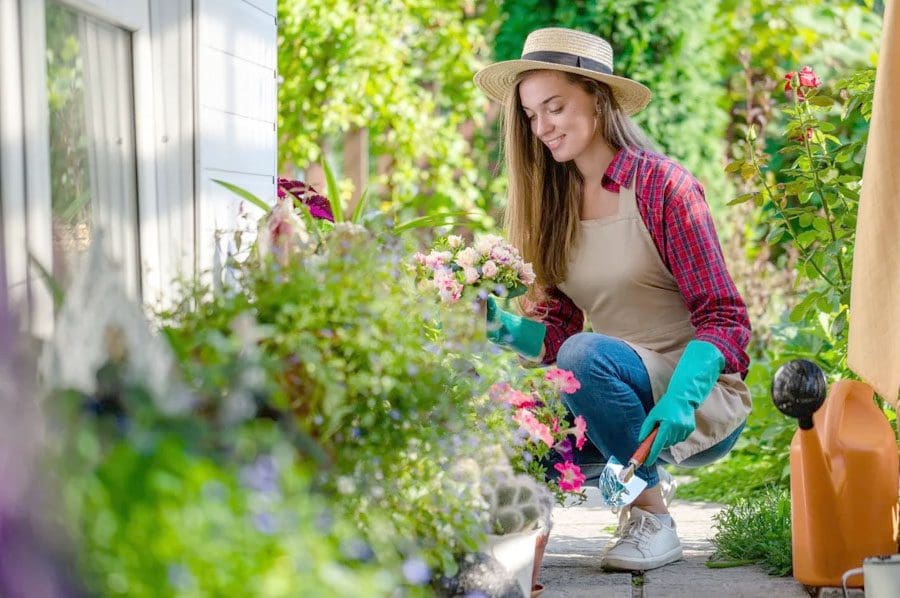Gardening is healthy for the body and does count as exercise, which works the major muscle groups that include the neck, shoulders, arms, abdomen, back, glutes, and legs. However, gardening can cause stress to the body with unhealthy posture/positioning, not using proper lifting techniques, using the wrong tools, and not taking breaks to stretch out the body, move around, and rehydrate. This can lead to body soreness, pain, and injuries. Here are some recommended gardening tips and stretches for pain prevention.

Gardening Tips and Stretches
A sore back and body can stem from staying in a single posture for too long and repetitive motions/movements. Here are a few tips to help maintain musculoskeletal health while gardening:
Tools
- Choosing the right garden tools can spare a lot of pain and money.
- Focus on the fundamental tools and purchase the best quality tools that the budget will allow.
- Size weight, task level, material, grips, handle length, and attachments are things to consider
- Maintaining quality tools will go a long way.
Digging
- Digging requires the right tools to get the job done safely and efficiently.
- Make sure the shovel is sharp enough to reduce using extra force to break up the dirt.
- The shovel handle should be long enough to avoid excessive bending.
- Utilize proper digging posture while using a shovel.
- If using too much pressure, soak the soil to loosen it up.
- Try not to twist when shoveling the dirt/soil; instead, move the whole body to where the dirt needs to be.
Lifting
- Prolonged lifting of bags, plants, pots, and equipment can take a toll on the spine and spinal muscles.
- Bend the knees and use the hips to lift, as the hip muscles are stronger than the low back muscles.
- Do not bend the waist to come back; use the hips.
- Investing in an elevated garden or gardening seat/stool is recommended to avoid bending.
Weeding
- Weeding can require prolonged sitting or bending, depending on the number of weeds.
- To avoid excessive sitting and bending, a gardening seat/stool can help, as well as a standing weeding tool will reduce the pressure on the back.
- This is also helpful for knee and/or hip pain.
Mowing
- Mowing with poor technique and improper posture can lead to increased strain and pain.
- This includes using proper arm positioning with a slight bend at the elbow and the mower handle at a comfortable level.
Take Breaks
- Do not push through; take a break even if the body feels great.
- Every half hour, the body needs to rest.
- Try to work in 30-minute increments then break to move around, stretch, relax, and rehydrate.
- Squatting, bending, digging, lifting bags, and pushing wheelbarrows is a form of strength training that helps achieve stronger muscles, healthier bones, and joints.
- But if there are no breaks, the chances for pain and injuries increase.
Stretches
Simple stretches can reduce the strain and pain of gardening. Stretching before, during, and after the gardening session is recommended.
Cat Stretch
- This is a simple yoga pose that helps with back soreness.
- On your hands and knees, keep the hands at shoulder distance and the knees at hip distance.
- Pull the navel up to the spine and arch/round the back.
- Slowly straighten the back.
Cow Stretch
- The cow stretch is the opposite of the cat pose.
- Start in the same position.
- Drop the stomach to the floor and lift the head up and back.
- The spine will arch and gently stretch the back.
Head Rolls
- Head rolls will help with shoulder and neck pain.
- Drop the chin down toward the chest.
- Gently roll the head to one side going around back to the center.
- Repeat in the opposite direction.
Supine Twists
- Supine twists can help the lower back.
- Lay down with the legs at a 45-degree angle and the arms out to the sides.
- Twist the legs to one side and look in the opposite direction.
- Hold the pose until the stretch is felt, and then move back to the starting point.
- Repeat on the opposite side.
Chiropractic
Chiropractic medicine can help alleviate aches and pains and rehabilitate, realign, and strengthen the body to optimal health. Individuals are educated on the musculoskeletal system, injury prevention, nutrition, and exercise to maintain wellness and a pain-free lifestyle.
Pain-Free Gardening Tips and Stretches
The information herein is not intended to replace a
one-on-one relationship with a qualified health care professional, or licensed
physician, and is not medical advice. We encourage you to make your own healthcare decisions based on your research and partnership with a qualified healthcare professional. Our information scope is limited to
chiropractic, musculoskeletal, physical medicines, wellness, sensitive health
issues, functional medicine articles, topics, and discussions. We provide and
present clinical collaboration with specialists from a wide array of
disciplines. Each specialist is governed by their professional scope of practice
and their jurisdiction of licensure. We use functional health & wellness
protocols to treat and support care for the injuries or disorders of the
musculoskeletal system. Our videos, posts, topics, subjects, and insights cover
clinical matters, issues, and topics that relate to and support, directly or
indirectly, our clinical scope of practice.* Our office has made a reasonable
attempt to provide supportive citations and has identified the relevant
research study or studies supporting our posts. We provide
copies of supporting research studies available to regulatory boards and the
public upon request.
We understand that we cover matters that require an
additional explanation of how it may assist in a particular care plan or
treatment protocol; therefore, to further discuss the subject matter above,
please feel free to ask Dr. Alex
Jimenez or contact us at 915-850-0900.
Dr.
Alex Jimenez DC, MSACP, CCST, IFMCP*, CIFM*, ATN*
email: coach@elpasofunctionalmedicine.com
Licensed in: Texas & New Mexico*
References
Howarth, Michelle et al. "What is the evidence for the impact of gardens and gardening on health and well-being: a scoping review and evidence-based logic model to guide healthcare strategy decision making on the use of gardening approaches as a social prescription." BMJ open vol. 10,7 e036923. 19 Jul. 2020, doi:10.1136/bmjopen-2020-036923
Masashi Soga A et al. "Gardening is beneficial for health: A meta-analysis" https://www.ncbi.nlm.nih.gov/pmc/articles/PMC5153451/pdf/main.pdf.
Scott, Theresa L et al."Positive aging benefits of home and community gardening activities: Older adults report enhanced self-esteem, productive endeavors, social engagement, and exercise" SAGE open medicine vol. 8 2050312120901732. 22 Jan. 2020, doi:10.1177/2050312120901732




